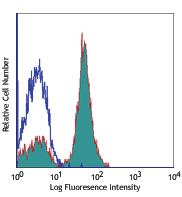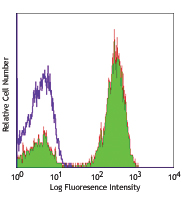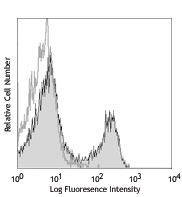- Regulatory Status
- RUO
- Other Names
- uPA, PLAU, ATF, QPD, UPA, URK, u-PA, BDPLT5
- Ave. Rating
- Submit a Review
- Product Citations
- publications

-
The activity of uPA was measured with 100 µM of fluorogenic uPA substrate, Bz-GGR-AMC, in the presence of 0.625, 1.25, 2.5, 5, 10, 20, and 40 ng of human uPA.
| Cat # | Size | Price | Quantity Check Availability | Save | ||
|---|---|---|---|---|---|---|
| 755302 | 10 µg | $218 | ||||
| 755304 | 25 µg | $382 | ||||
Urokinase-type plasminogen activator, also known as uPA, is secreted as a 411 amino acid single-chain proenzyme that is composed of an N-terminal GFD (growth factor-like domain) (amino acids 1–43), which binds to uPAR, a kringle domain (amino acids 44–135) and a C-terminal serine protease domain (amino acids 136–411). The proenzyme has little or no enzymatic activity, and it is activated upon cleavage by plasmin at Lys158-Iso159 to generate a two-chain molecule, which converts plasminogen into plasmin. The activated enzyme (uPA) cleaves other substrates such as VEGF and HGF. Sequentially, plasmin degrades the ECM and stimulates the local release of growth factors promoting cell adhesion, migration, and proliferation. The receptor for uPA is present on the surface of many cell types, it regulates proteolysis by binding the extracellular protease uPA, and also activates many intracellular signaling pathways that promote cell motility, invasion, proliferation, and survival. Thus, uPAR interaction with β1 integrin is required for PDGF-AB-induced human mesenchymal stem (MSC) and stromal cell migration. Additional studies have shown that uPA and PDGF have a synergistic effect on airway smooth muscle cell migration. uPA/uPAR also play a key role in regulating the migration and differentiation of MSC. uPAR is overexpressed in a variety of tumor cell lines and tissues, which include breast, ovary, lung, pancreas, colon, kidney, liver, stomach, and the endometrium. High levels of uPAR are associated with cancer invasion and metastasis.
Product DetailsProduct Details
- Source
- Human uPA, amino acids (Ser21-Leu431) (Accession# P00749.2), with C-terminal TG-10His-GGQ tag was expressed in 293E cells.
- Molecular Mass
- The 426 amino acid recombinant protein has a predicted molecular mass of approximately 48.1 kD. The DTT-reduced protein migrates at approximately 18 kD (chain A) and 38 kD (chain B) and the non-reduced protein migrates at approximately 55 kD by SDS-PAGE.
- Purity
- >95%, as determined by Coomassie stained SDS-PAGE.
- Formulation
- 0.22 µm filtered protein solution is in PBS, pH 7.2.
- Endotoxin Level
- Less than 1.0 EU per µg of protein as determined by the LAL method.
- Concentration
- 10 and 25 µg sizes are bottled at 200 µg/mL.
- Storage & Handling
- Unopened vial can be stored at -70°C for six months. For maximum results, quick spin vial prior to opening. Avoid repeated freeze/thaw cycles.
- Activity
- Human uPA cleaves the peptide substrate Bz-GGR-AMC with a specific activity value higher than 2,000 pmol/µg/min.
- Application
-
Bioassay
- Application Notes
-
BioLegend carrier-free recombinant proteins provided in liquid format are shipped on blue-ice. Our comparison testing data indicates that when handled and stored as recommended, the liquid format has equal or better stability and shelf-life compared to commercially available lyophilized proteins after reconstitution. Our liquid proteins are verified in-house to maintain activity after shipping on blue ice and are backed by our 100% satisfaction guarantee. If you have any concerns, contact us at tech@biolegend.com.
- Product Citations
-
Antigen Details
- Structure
- Monomer as proenzyme and dimer activated enzyme.
- Distribution
- Urine, blood, and extracelluar matrix.
- Function
- Converts plasminogen into plasmin, cell migration, angiogenesis, wound repair, inflammation, immunity, and tumor metatases. uPA mediates neointimaformation after injuries.
- Interaction
- Many cell types such as myeloid cells, endothelial cells, epithelial cells, vascular smooth muscle cells, and mesenchymal stem cells.
- Ligand/Receptor
- uPA receptor (uPAR, CD87).
- Bioactivity
- Human uPA activity is measured by its ability to cleave a fluorogenic peptide substrate Bz-GGR-AMC.
- Biology Area
- Stem Cells
- Molecular Family
- Enzymes and Regulators
- Antigen References
-
1. Lijnen HR, et al. 1988. Eur. J. Biochem. 172:185.
2. Ploug M, et al. 1991. J. Biol. Chem. 266:1926.
3. Carlin SM, et al. 2003. Am. J. Physiol. Lung Cell Mol. Physiol. 284:L1020.
4. Gutova M, et al. 2008. Stem Cells 26:1406.
5. Smith HW, Marshal CJ. 2010. Nature Rev. Mol. Cell Biol. 11:23.
6. Li D, et al. 2013. Theranostics 3:507.
7. Chabot V, et al. 2015. Stem Cell Res. Ther. 6:188. - Gene ID
- 5328 View all products for this Gene ID
- UniProt
- View information about u-Plasminogen Activator on UniProt.org
Related FAQs
- Why choose BioLegend recombinant proteins?
-
• Each lot of product is quality-tested for bioactivity as indicated on the data sheet.
• Greater than 95% Purity or higher, tested on every lot of product.
• 100% Satisfaction Guarantee for quality performance, stability, and consistency.
• Ready-to-use liquid format saves time and reduces challenges associated with reconstitution.
• Bulk and customization available. Contact us.
• Learn more about our Recombinant Proteins. - How does the activity of your recombinant proteins compare to competitors?
-
We quality control each and every lot of recombinant protein. Not only do we check its bioactivity, but we also compare it against other commercially available recombinant proteins. We make sure each recombinant protein’s activity is at least as good as or better than the competition’s. In order to provide you with the best possible product, we ensure that our testing process is rigorous and thorough. If you’re curious and eager to make the switch to BioLegend recombinants, contact your sales representative today!
- What is the specific activity or ED50 of my recombinant protein?
-
The specific activity range of the protein is indicated on the product datasheets. Because the exact activity values on a per unit basis can largely fluctuate depending on a number of factors, including the nature of the assay, cell density, age of cells/passage number, culture media used, and end user technique, the specific activity is best defined as a range and we guarantee the specific activity of all our lots will be within the range indicated on the datasheet. Please note this only applies to recombinants labeled for use in bioassays. ELISA standard recombinant proteins are not recommended for bioassay usage as they are not tested for these applications.
- Have your recombinants been tested for stability?
-
Our testing shows that the recombinant proteins are able to withstand room temperature for a week without losing activity. In addition the recombinant proteins were also found to withstand four cycles of freeze and thaw without losing activity.
- Does specific activity of a recombinant protein vary between lots?
-
Specific activity will vary for each lot and for the type of experiment that is done to validate it, but all passed lots will have activity within the established ED50 range for the product and we guarantee that our products will have lot-to-lot consistency. Please conduct an experiment-specific validation to find the optimal ED50 for your system.
- How do you convert activity as an ED50 in ng/ml to a specific activity in Units/mg?
-
Use formula Specific activity (Units/mg) = 10^6/ ED50 (ng/mL)

 Login/Register
Login/Register 













Follow Us